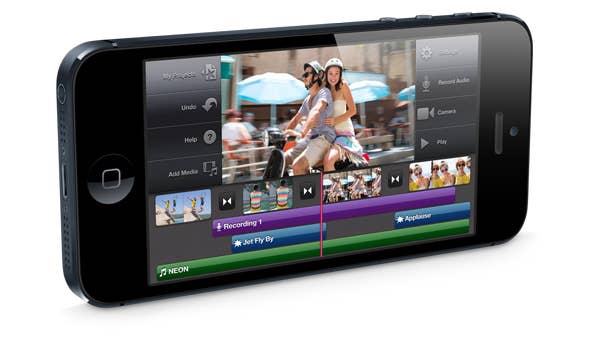Whatever happened to the iPad mini?
Why the new iPod Touch is a better bet than a downsized iPad, plus the Digital Foundry take on the iPhone 5 reveal
In the wake of the launch of the ultra-cheap Google Nexus 7 and the Amazon Kindle Fire HD, many were wondering when Apple would be releasing its own mini-tablet to take on the new pretenders - the so-called iPad mini. The funny thing is that the Cupertino superpower did just that last week - but not many people appear to have actually noticed.
"The revival of the iPod Touch is Apple's response to the arrival of cheap 7-inch iPad competitors, with a price-point that seems to rule out the arrival any time soon for an iPad mini"
The fact of the matter is that Apple already has its own miniaturised iPad - the iPod Touch - and the timing and pricing of the new model announced last week strongly suggests that this could well be the entirety of the Cupertino superpower's response to the two-pronged Android offensive from Google and Amazon.
The make-up of the new device is intriguing - a mixture of core components from the iPhone 4S and the new iPhone 5, remixed into an enticing, if perhaps pricey package. Processor-wise, Apple falls back on its established A5 architecture, marrying dual core ARM Cortex A9s with a PowerVR SGX543MP2 - the firm suggesting that the new model is good for 40 hours of music playback, or eight hours of video on a single charge. This suggests that the 32nm version of the A5, as seen in the revised iPad 2, also gets an outing here.
The newly upgraded Retina display appears to be a match for the new screen found on the iPhone 5 - retaining the 640 pixel horizontal resolution found on the existing fourth gen iPod Touch, but enlarged vertically from 960 to 1136 pixels. Apple's pitch here is that the device is still small enough to be used in one hand, but the additional 18 per cent of resolution makes for easier consumption of web media, with the 16:9 aspect ratio a perfect fit for much of the latest video content from iTunes.
It can easily be argued that a sub-HD 4-inch display - no matter how densely packed with pixels, or how vivid the colours are - can match the real estate offered by the 7-inch 1280x800 displays found on the Nexus 7 or Fire HD, but Apple's response appears to be to turn this apparent weakness into a strength, by putting a strong emphasis on tech that's completely missing from its rivals in other areas.

Quite rightly, the Google and Amazon products dispense with rear-facing cameras - the tablet form factor just isn't a good match for photography or impromptu video-making. However, the dinky form factor of the iPod Touch makes it perfect as a point and shoot camera, with the iSight optics allowing for five-megapixel shots and 1080p video. The new Panorama photo feature from the iPhone 5 also gets bundled into the package as well, and there doesn't appear to be any skimping on the other new features from the upcoming iOS 6 either.
"The A5 architecture is still highly competitive, and in 3D applications the new iPod Touch should be able to get close to iPad 2 and iPad 3 performance, and out-class the vast majority of Android smartphones."
Games-wise, the reliance on A5 architecture might come as a disappointment bearing in mind that previous iPod Touches have essentially mirrored the processing power of the corresponding iPhone released the same year. However, this year's iPad refresh doubled GPU power simply to maintain the ultra-resolution 2048x1536 "Retina" display. Indeed, in many demanding 3D games, the "new iPad" actually underperforms compared to the lower resolution iPad 2. The new iPod Touch offers up an eight per decent resolution deficit up against the iPad 2, which shares the same processor, so in demanding 3D applications it should still offer an experience fairly close to the tablet products. We could see a dip in frame-rates if Apple has carried out its usual 20 per cent downclock when its tablet processors migrate across to smaller form-factors though: managing battery life is the key here in a device so small.
So with the iPod Touch already being an established product, why does the reveal of a new fifth generation model make an iPad mini debut less likely? It's all about the price-point - the somewhat high £249/$299 is obviously a lot more expensive than both the Kindle Fire HD and the Nexus 7, so the concept of Apple effectively launching against itself imminently suddenly seems a lot less likely. It can be argued that with the iPod Touch/iPad 2/new iPad straddling a range of pricing brackets, there's simply no room to cram in another product.
Justification for the higher price appears to come from the allocation of storage: the entry-level fifth gen iPod Touch starts at 32GB with a 64GB variant commanding a £80/$100 premium. Bearing in mind that universal apps are getting bigger to accommodate the iPad's Retina display (both 2D artwork and 3D textures occupy more RAM), the move up to a higher level of storage is welcome, but the pricing penalty here seems somewhat high bearing in mind how cheap memory has become in recent times.
So despite not producing a 7-inch tablet, and not choosing to participate in "race to the bottom" pricing with its nearest rivals, Apple has indeed responded to the challenge set by Google and Amazon, and it has done so simply by resurrecting a product line many thought destined for extinction. It may not be the approach that many might have wanted, but it's typical Apple - smaller and pricier than the competition, but a highly compelling proposition nonetheless, somehow managing to appeal to both gadget geeks and the mainstream in equal measure.

It's a sentiment that equally sums up the real star of the show at Apple's briefing last week: the iPhone 5. The trend in Android handsets has been to go bigger, lavishing extreme resolutions on ever-expanding displays, and increasing CPU core count - a state of affairs summed up perfectly by the Samsung Galaxy S3, an excellent, if outsized quad core handset. Apple's approach? A relatively minor 18 per cent increase in display size and a single-minded focus on the user experience, from the look and feel of the device to what looks like an unprecedented level of fidelity in the quality of the display.
"iPhone 5's CPU appears to be dual core in nature, running at 1GHz. Apple appears to have customised the ARM architecture in order to achieve an impressive 2x performance gain over the 4S."
Based on unconfirmed Geekbench scores, it also appears that Apple has resisted the temptation to retake the smartphone performance crown (from a CPU perspective at least) simply by scaling up processing cores. Anandtech's theory, which seems plausible, suggests that the new A6 features dual customised ARM cores with radical performance increases over the more common or garden Cortex A9 set-up of the A5 processor. Clock speed appears to be scaled up to 1GHz, and memory bandwidth increased enormously - there's also a strong suggestion that access to storage has been significantly improved too. While sheer horsepower isn't quite a match for the most powerful Android phones, Apple has the advantage of being able to tailor its OS to match its hardware - which should result in class-leading performance.
From a graphics perspective, iPhone 5 doesn't offer up the kind of revolutionary, current-gen console quality we should expect from the next-gen PowerVR Series 6 Rogue architecture. It's a crazy world in which a 2x GPU power boost might be considered a touch disappointing, but the stat from Apple hints at a PowerVR SGX543 MP4 component in the new phone - the same as that found within the latest iPad, and indeed the PlayStation Vita. Console quality graphics? Not quite. Vita is still a step away from PS3 quality, and that has the benefit of giving developers direct access to the core architecture - a state of affairs Apple can't really compete with. The Real Racing 3 reveal at last week's event shows the gap closing between mobile and current-gen console though, and SGX543 MP4 horsepower deployed on a screen with less of a fill-rate overhead than the non-Retine iPad screen should produce some excellent results. Ever since the launch of the iPad 2, Apple has invested strongly in graphics performance and in iPhone 5, the firm appears to have once again set the bar - until the first mobile products with PowerVR Rogue appear sometime next year at least.
In the meantime, with two million pre-orders in the bag and resultant shortages sure to make the iPhone 5 even more desirable, all the evidence seems to point to another big win for Apple. A share price now nudging $700 can't be argued with either.

